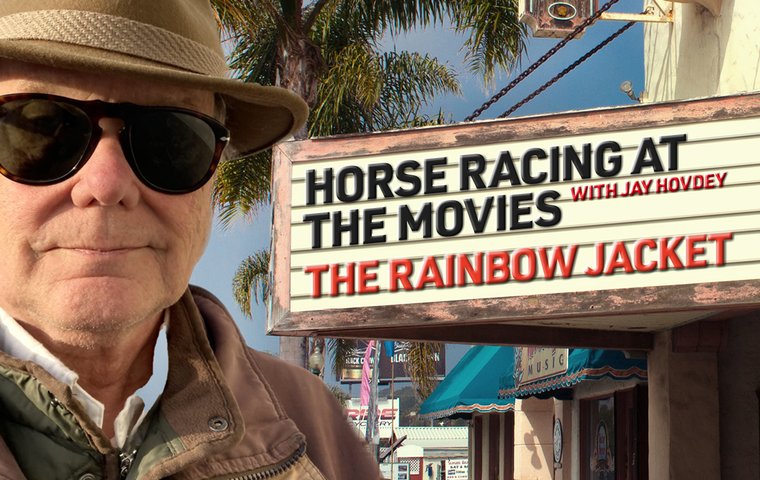
In his latest missive from the movie house, our film correspondent trawls the archive to discover a long-forgotten 1950s effort from the legendary Ealing Studios
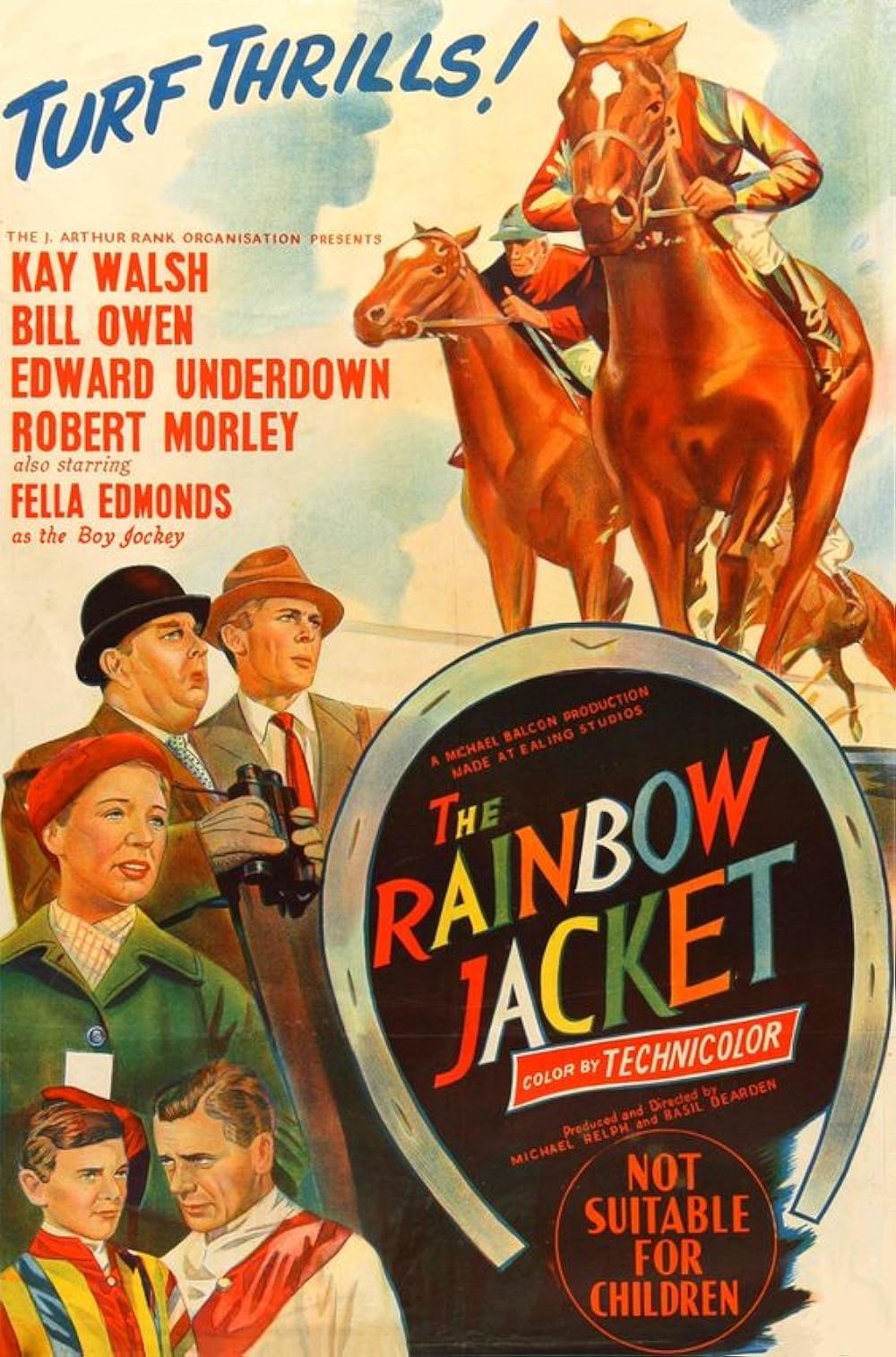 The Rainbow Jacket (1954)
The Rainbow Jacket (1954)
directed by Basil Dearden; starring Bill Owen, Fella Edmonds, Kay Walsh, Robert Morley
A recent post from a movie fan on a social media site confessed to watching for the first time a little flick called The Godfather. Since I was fairly certain they were older than 35, I was somewhat mystified at the hole in their viewing history. Thankfully, I refrained from kneejerk snark and let the moment pass.
Good thing, too. Not long after that, I discovered a stone cold horse racing classic from nearly 70 years ago that I’d never heard of, let alone seen. My mistake, now corrected.
British racing movies from the era tend to travel in light-hearted romps through betting coups or local yokels banding together to buy a horse and shoot for the moon. No harm in that.
Anyway, who are we Yanks to criticize, when the default product back then was one after another versions of Mickey Rooney as a jockey, or a warmed-over Damon Runyon tale with Bob Hope or Bing Crosby?
The Rainbow Jacket emerged from the legendary Ealing Studios, a West London outfit that has been in business since 1902. Ealing flourished in the post World War II years with classics like The Lavender Hill Mob, Passport to Pimlico, and Kind Hearts and Coronets.
For The Rainbow Jacket, Ealing called upon a core of its best resources, including director Basil Dearden, producer Michael Relph, and screenwriter T. E. B. ‘Tibby’ Clarke.
Dearden and Relph were considered Ealing’s workhorses, churning out features of varying quality over a breakneck decade full of comedies, war stories, and social dramas. The Rainbow Jacket followed hard on the heel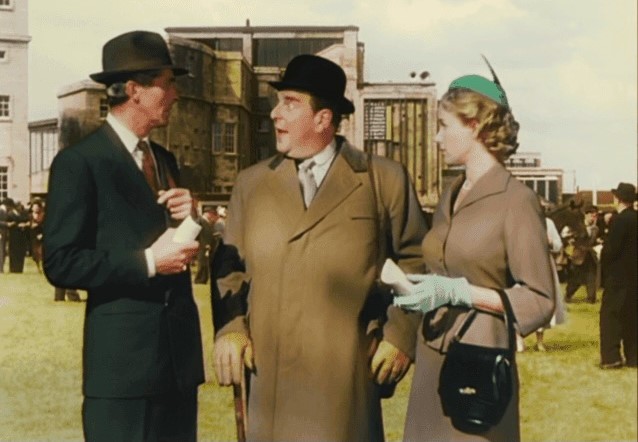 s of their well-regarded brush with boxing in The Square Ring, and Dearden would later direct the landmark Victim, with Dirk Bogarde.
s of their well-regarded brush with boxing in The Square Ring, and Dearden would later direct the landmark Victim, with Dirk Bogarde.
Racing buff
As for Clarke, by the time he sat down to write The Rainbow Jacket, he’d already won an Academy Award in the category of Best Story and Screenplay for The Lavender Hill Mob, a wryly funny caper flick starring Alec Guinness.
Apparently, Clarke was a racing buff, and it shows, as his characters smoothly navigate a series of racetrack settings as if they belonged.
Clarke’s protagonists meet sneaking into the far reaches of Lingfield Park racecourse. Sam Lilly is a jockey banned for race-fixing and Georgie Crain is 13, broke, and horse crazy.
It’s the angle of fledgling-and-mentor hatched in the same corner of the imagination as movies like Boots Malone and The Black Stallion. For reasons that seem self-serving but harmless, Sam takes Georgie under his wing and teaches him the ropes. The plot kicks into gear when the two of them collar a runa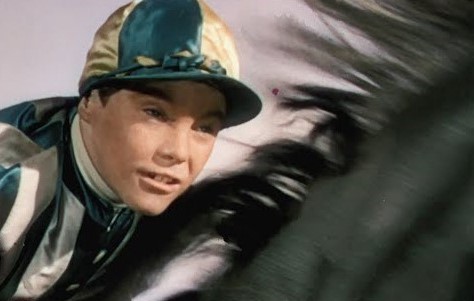 way horse at Sandown Park, which lands Georgie a job in a classy but struggling stable.
way horse at Sandown Park, which lands Georgie a job in a classy but struggling stable.
So far, so-so. But then, as the second act begins, the filmmakers take a deep breath and allow the story to be carried from the point of view of wide-eyed Georgie. The camera lingers on the depot sign ‘Newmarket’ when the boy steps off the train, as if he has just arrived at Lourdes.
Making his way down High Street, he peeks into the Boyce & Rogers tack shop and beholds its forbidden treasures. He asks directions of a bobby touting a horse to a passerby. Then he arrives at the gates of Ormonde House to a swell of music, as if Shangri-La awaits just inside.
Suspicous of the newcomer
Well, it kinda does. As the training yard is revealed from the boy’s point of view, the full force of its heady romance lands hard. It is daunting as well, but nothing discourages young Georgie, neither the gruff head lad nor the rival stable hand, suspicious of the newcomer.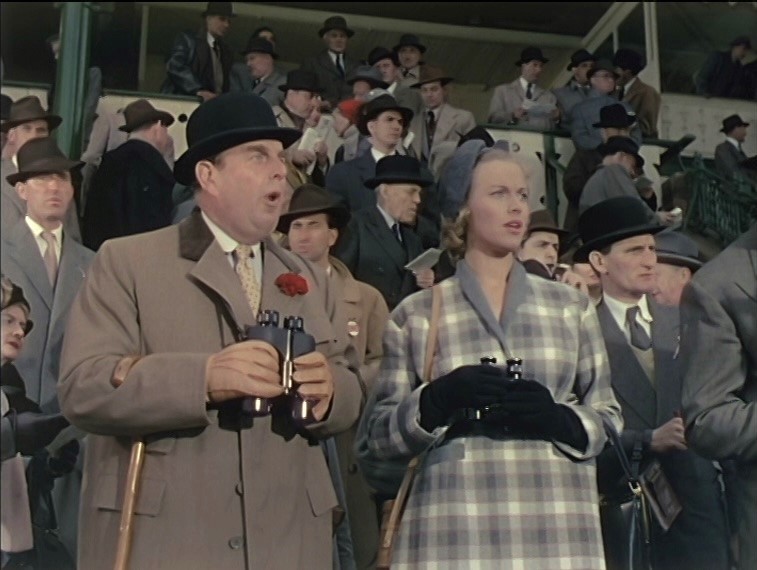
Soon, Georgie gets a shot to ride in a ‘boys’ race’, one notch below apprentices. He enters the jockeys’ room at Newmarket Racecourse, mouth agape at the rack of nameplates destined for special cubicles, bearing names that a well-rounded racing fan of any age should immediately recognize: L. Piggott, J. Mercer, Gdn. Richards. An older jockey introduces the rookie to a valet with a sardonic: “I’ve broken the news to Sir Gordon. He’s now trembling at the knees.”
As the valets share a laugh, Gordon Richards himself appears in the background, slipping quietly onto the weighing scale. Richards was knighted by young Queen Elizabeth in 1953, during her first year as monarch. Richards appears in a few other scenes of The Rainbow Jacket, and his lines are forgettable. But as in life, during an exemplary career of 26 British titles, he does not embarrass himself.
John Hislop, the former rider and prolific author, served as the film’s “Racing Consultant”, according to 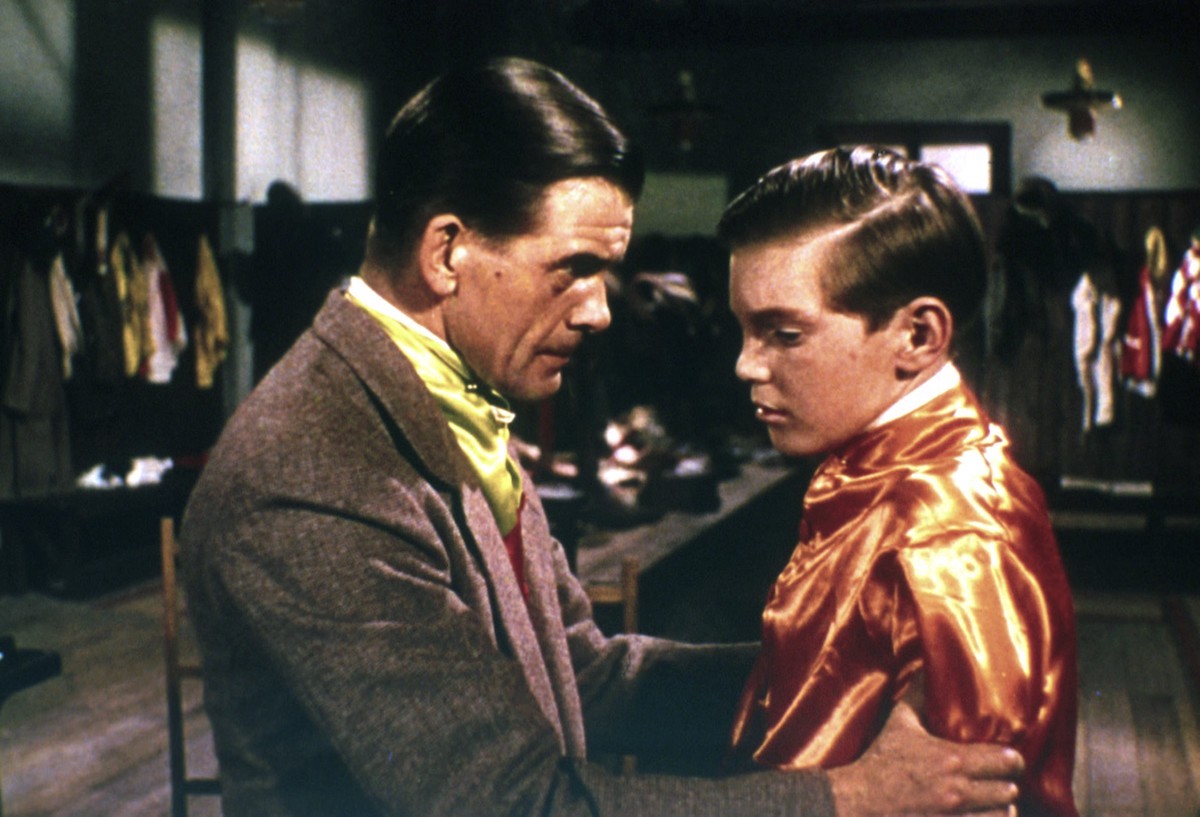 a prominent display during the opening credits. At this remove, it is hard to say where Clarke’s dialogue stood aside and Hislop’s influence began, although there’s not much doubt about a line like this, delivered by the valet as he hands Georgie the whip:
a prominent display during the opening credits. At this remove, it is hard to say where Clarke’s dialogue stood aside and Hislop’s influence began, although there’s not much doubt about a line like this, delivered by the valet as he hands Georgie the whip:
“And remember, there’s more races lost with these than won with them.”
Or this, when the trainer introduces Georgie to the yard’s head lad:
“This is the boy I was telling you about. He can ride already, which is more than most of them can when they come here.”
Or this, when Sam is trying to convince Georgie’s mother to give her son a shot at learning how to ride:
“It’s not only the hands and the seat and the strength and balance that makes a jockey,” Sam says. “You give me a boy 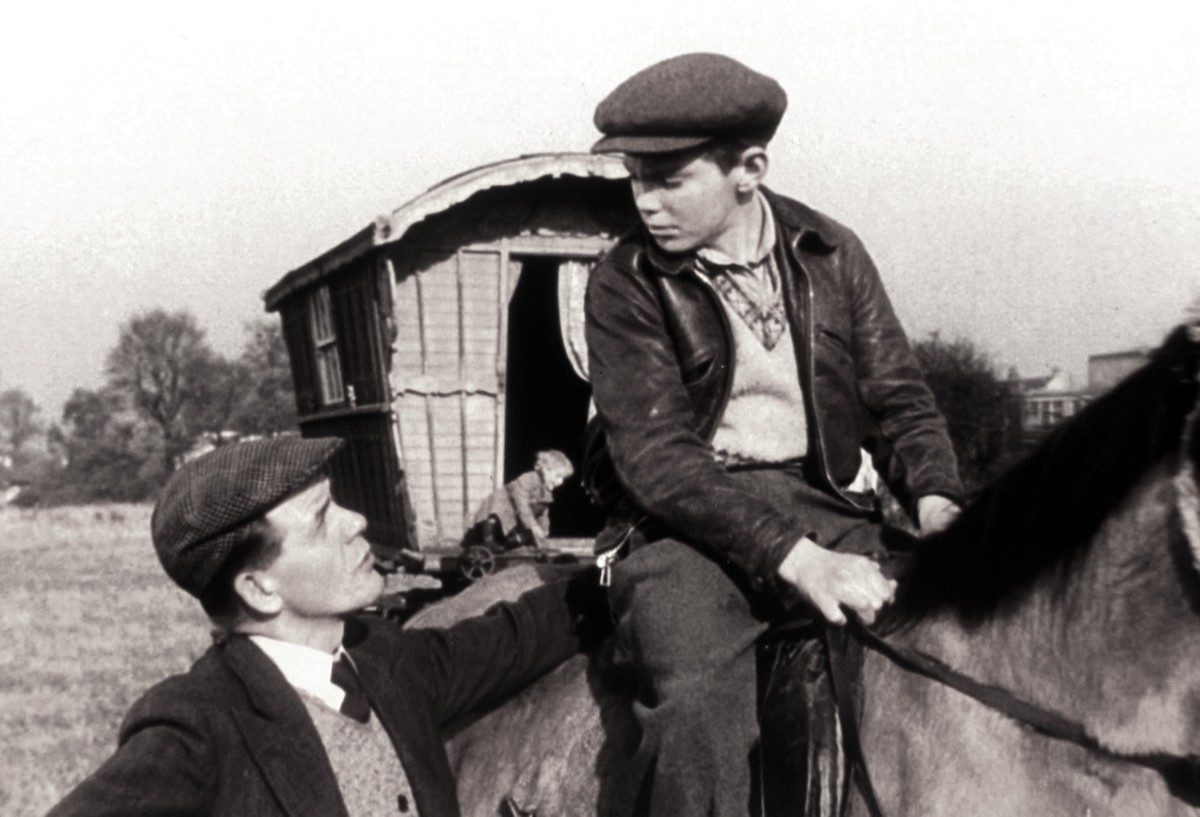 that’s willing to learn and I can teach him all them things and teach him good, too. But there’s one thing I can’t teach him, nor can anybody else. It’s gotta be with him from the day he was born. And here’s the laugh – I can't even tell you what it is. It may sound crazy to you, but there’s no more than one in a million that’s got it.”
that’s willing to learn and I can teach him all them things and teach him good, too. But there’s one thing I can’t teach him, nor can anybody else. It’s gotta be with him from the day he was born. And here’s the laugh – I can't even tell you what it is. It may sound crazy to you, but there’s no more than one in a million that’s got it.”
Apprentice sensation
Georgie’s got it, and then some. He becomes an apprentice sensation, winning races in bunches all over the British map.
Still, those of us who have watched way too many of these stories keep waiting for the other boot to drop and some unfortunate circumstance befall the young phenom. When it happens, amidst a tangle of desperate, selfless measures, the viewer’s thoughts may wander to The Gift of the Magi by O. Henry, and how a sacrifice in the name of love and family can backfire.
Critics of the time look upon The Rainbow Jacket as a lesser Ealing Studios effort, and there are admittedly a few production shortcuts on the technical side. But the Technicolor photography sets it apart for its time, the racetrack and training yard scenes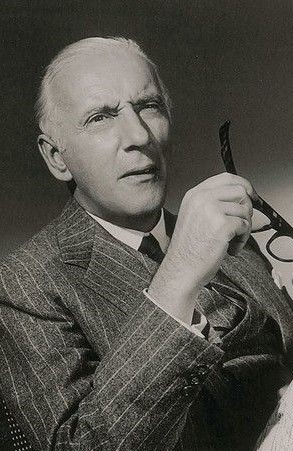 are evocative enough, and only a fussy grouch would have a bad word to say about the performances of such British stalwarts as Bill Owen, Robert Morley, Kay Walsh, Edward Underdown, and Wilfrid Hyde-White (right).
are evocative enough, and only a fussy grouch would have a bad word to say about the performances of such British stalwarts as Bill Owen, Robert Morley, Kay Walsh, Edward Underdown, and Wilfrid Hyde-White (right).
Edwin ‘Fella’ Edmonds, who acted his age as Georgie, had a short film career. He is clearly a work in progress, but he is directed well enough to hold up his end of the tale. Bernard Lee, who later played M in the first batch of James Bond movies, has a cameo as a faintly respectable crime boss.
And if you want to know what Honor Blackman was doing 10 years before she became Pussy Galore in Goldfinger, there she is on Newmarket Heath astride a fine pony as the trainer’s wife.
• The Rainbow Jacket can be found on an off-brand streaming site but is also readily available for a reasonable price on DVD and Blu-ray
• View all Jay Hovdey’s features in his Favorite Racehorses series
Phar Lap: how a Melbourne Cup icon became a hero of the silver screen
Horse racing at the movies: The Killing is a polished gem in a poisonous setting
Horse racing at the movies: Calvin Borel’s reaction to winning on Mine That Bird was movie magic
Horse racing at the movies: The Black Stallion is a bonafide classic among the greatest horse fables
Horse racing at the movies: Casey’s Shadow gets into the details like few feature films
Horse racing at the movies: Champions was different from the maudlin crowd
View the latest TRC Global Rankings for horses / jockeys / trainers / sires


